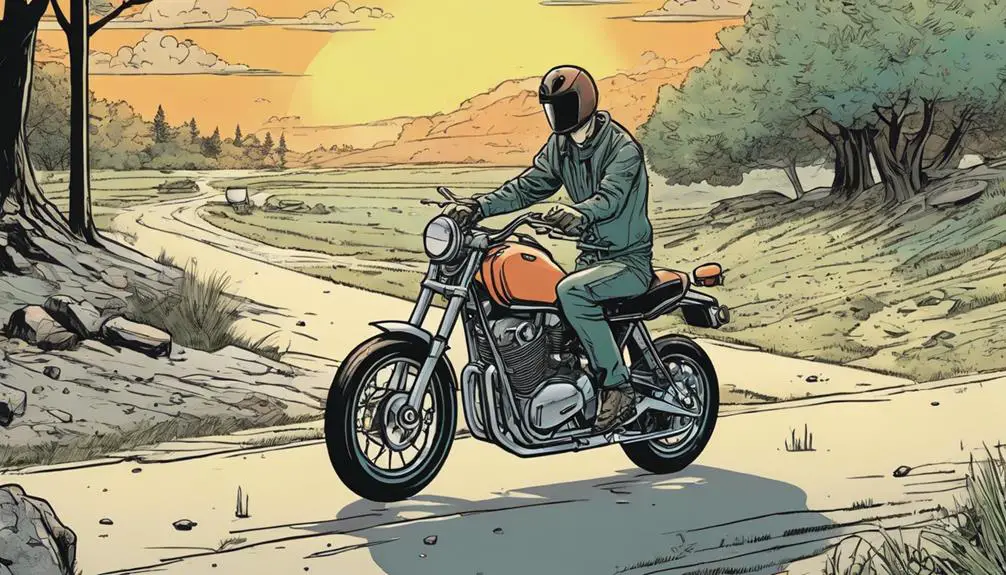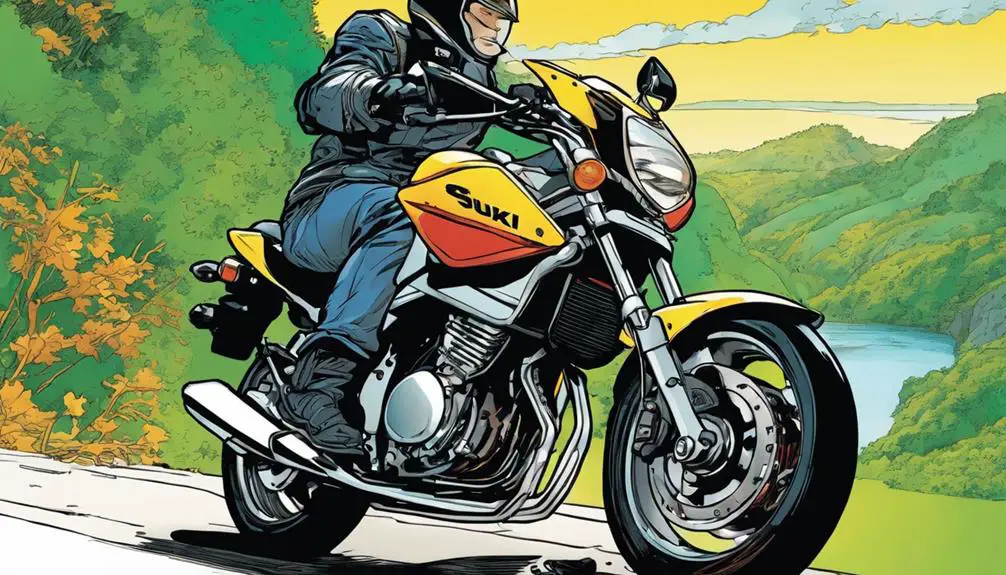Picture yourself steering a winding road, the weight of your motorcycle shifting beneath you as you lean into a turn. You might not realize how essential that weight is to your safety and control. Whether you're riding a nimble bike that dances through traffic or a heavier model that feels stable at high speeds, each choice affects your handling and overall experience. As you consider the implications of weight on your ride, think about how it influences not just your maneuverability but also your safety on the road ahead.
Quick Takeaways
- Motorcycle weight affects handling and stability, influencing safety during maneuvers and while navigating various road conditions.
- Lighter motorcycles offer greater agility for quick responses in urban environments, enhancing rider safety in traffic.
- Heavier motorcycles provide stability at high speeds, but may hinder control at low speeds, impacting overall safety.
- Proper weight distribution is essential for maintaining control, especially during turns and braking, contributing to safer rides.
Importance of Motorcycle Weight

When choosing a motorcycle, understanding its weight is crucial, as it directly affects your handling, stability, and overall safety on the road. A lighter bike can offer you agility, allowing for quick maneuvers, especially in tight situations or urban environments. You'll feel more in control, enhancing your confidence and freedom as you ride.
Conversely, heavier motorcycles can provide stability at high speeds, but they may feel cumbersome, particularly during low-speed turns or when maneuvering through traffic.
Think about how weight impacts your riding style. If you crave adventure and spontaneity, a lighter motorcycle might align better with your desire for liberation. It'll empower you to explore winding roads and off-the-beaten-path trails without feeling bogged down.
On the other hand, if you're drawn to longer journeys on highways, you might appreciate the comfort a heavier bike can offer.
Ultimately, you need a motorcycle that resonates with your spirit. By carefully considering the weight, you'll not only enhance your riding experience but also guarantee your safety and enjoyment on every ride.
Choose wisely, and let the open road be your playground.
Suzuki Motorcycle Weight Specifications
When considering Suzuki motorcycles, the weight specifications play a vital role in your overall riding experience.
You'll notice how weight distribution affects handling dynamics, making it important to understand each model's limits.
Plus, keeping an eye on weight regulations can help guarantee you're riding safely and legally.
Importance of Weight Distribution
Proper weight distribution is essential for maintaining stability and control on your Suzuki motorcycle. When you ride, how you position your body can greatly impact your overall experience and safety. Achieving the right balance helps you navigate curves and respond effectively to road conditions, giving you the freedom to ride with confidence.
Think about it: your weight should be evenly distributed between the front and rear wheels. If you're too far forward or back, it can lead to instability, making your ride less enjoyable. Adjust your posture, lean into turns, and shift your weight as needed to stay in sync with your bike. This dynamic relationship between you and your Suzuki can unleash a thrilling sense of liberation.
Moreover, carrying extra gear or passengers alters your weight distribution. Be mindful of how that affects your ride. Before hitting the road, check that your load is balanced, ensuring you can tackle any adventure that comes your way.
Impact on Handling Dynamics
Understanding Suzuki motorcycle weight specifications is essential for optimizing handling dynamics and enhancing your riding experience. When you know the weight of your bike, you can make informed decisions that improve stability and maneuverability. A lighter motorcycle generally offers quicker responses, allowing you to weave through traffic or tackle tight corners with ease.
On the other hand, a heavier model may provide a more stable ride at high speeds, which can be vital for long-distance journeys. The weight distribution also plays a significant role; it affects how the bike leans into turns and absorbs shocks from the road.
By familiarizing yourself with the specific weight of your Suzuki, you can adjust your riding style to match. For instance, if your bike is on the heavier side, you might shift your body weight more actively during turns to maintain control.
Ultimately, understanding these dynamics empowers you to ride with confidence and freedom. You're not just riding a motorcycle; you're experiencing the open road in a way that resonates with your spirit of adventure.
Weight Limits and Regulations
Weight limits and regulations for Suzuki motorcycles play a crucial role in ensuring safety and performance on the road. When you choose a Suzuki, you're not just picking a bike; you're embracing the thrill of freedom while staying grounded in safety.
Each model has specific weight specifications that dictate how much you can safely carry. This includes your weight, any passengers, and additional gear. Exceeding these limits can compromise stability and handling, which may lead to accidents or loss of control.
For instance, if you're riding a Suzuki GSX-R, its weight limit is designed to optimize balance and maneuverability, enhancing your riding experience. Understanding these specifications helps you make informed decisions, keeping your ride exhilarating yet safe.
Moreover, Suzuki's commitment to safety extends to their engineering, ensuring that every motorcycle meets rigorous standards. When you respect these weight limits, you're not just following regulations; you're taking charge of your ride.
Impact on Handling and Control

A motorcycle's handling and control are greatly affected by how much it weighs, impacting your riding experience and safety.
When you ride a lighter motorcycle, you'll notice it's easier to maneuver, allowing you to weave through traffic or take sharp turns with confidence. You'll feel more connected to the road, enhancing your sense of freedom as you ride.
On the other hand, heavier motorcycles can feel cumbersome, especially at low speeds. If you're not careful, this added weight can lead to fatigue and decreased control, which can be dangerous in vital situations. The more weight you're dealing with, the more effort it takes to steer and balance, which can detract from that liberating riding experience you crave.
You should also consider how weight affects your braking. A heavier bike requires more distance to stop, which can be a significant factor in avoiding accidents.
Ultimately, understanding how weight impacts handling empowers you to choose a motorcycle that aligns with your riding style and safety needs, ensuring you can enjoy the open road with the control and confidence you deserve.
Weight Distribution and Stability
Balancing your motorcycle's weight distribution is essential for maintaining stability while riding. When you distribute weight evenly across your bike, it enhances control, allowing you to navigate curves and obstacles with confidence. Imagine feeling the freedom of gliding smoothly through bends, where your motorcycle responds effortlessly to your movements.
To achieve the best weight distribution, consider how you position yourself and any cargo. Your body weight should align with the bike's center of gravity. Leaning into turns helps maintain balance, while shifting your weight during acceleration or braking guarantees you stay in control.
If you carry luggage, secure it properly and position it low and centered to prevent instability.
Safety Features in Suzuki Models

When you choose a Suzuki motorcycle, you're getting more than just style; you're also benefiting from advanced safety features.
With systems like stability control and anti-lock brakes, you can ride with confidence, knowing you have support when it matters most.
Plus, the lightweight frame design enhances maneuverability, making your ride safer overall.
Advanced Stability Control Systems
Suzuki's advanced stability control systems enhance your riding experience by providing superior traction and control in various conditions. Imagine tearing down winding roads, feeling the rush of freedom while your bike intuitively adapts to the terrain beneath you. These systems automatically adjust power delivery and braking forces, ensuring you maintain your grip even when the road gets tricky.
When you're riding through rain, gravel, or unexpected obstacles, Suzuki's technology steps in to keep you upright and confident. You won't have to worry about losing control; instead, focus on the thrill of the ride. This feature allows you to push boundaries, knowing your motorcycle is equipped to handle diverse environments without compromising your safety.
Additionally, these systems work seamlessly in the background, giving you the liberation to explore without hesitation. With advanced stability control, you're not just riding; you're embracing every twist and turn with enhanced assurance.
Anti-lock Braking Technology
Anti-lock braking technology greatly enhances your safety, ensuring you maintain control during sudden stops or slippery conditions.
When you ride a Suzuki equipped with this feature, you experience the freedom of braking without fear of losing traction. The system prevents your wheels from locking up, allowing you to steer effectively even in challenging circumstances.
Imagine cruising down a winding road, the wind in your hair, when suddenly, you face an unexpected obstacle. With anti-lock braking, you can apply pressure to the brakes confidently, knowing the system will modulate the brake force. This responsiveness encourages you to take risks while knowing you're protected.
Suzuki models incorporate this technology seamlessly, making it an integral part of your riding experience. Whether you're maneuvering through city streets or tackling mountain passes, the assurance of anti-lock brakes lets you focus on the thrill of the ride. You'll find yourself more in tune with your bike, liberated from the worry of skidding or losing control.
In a world where safety and adventure coexist, anti-lock braking technology empowers you to ride boldly. Embrace the open road, knowing that your Suzuki has your back.
Lightweight Frame Design Benefits
Experience the advantages of a lightweight frame design in Suzuki models, which enhances maneuverability and stability, ultimately boosting your safety on the road.
When you ride a Suzuki, you'll notice how effortlessly it glides through corners and adapts to sudden changes in traffic. This nimble design allows you to respond quickly, giving you that liberating feeling of control.
A lightweight frame doesn't just make your ride more enjoyable; it greatly reduces the overall weight of the motorcycle, making it easier to handle. With less mass to manage, you can confidently navigate tight spots and dodge obstacles, ensuring a safer journey.
Plus, the stability gained from this design provides you with a solid platform, minimizing the risk of wobbling or losing balance.
Additionally, Suzuki's commitment to using advanced materials means that even with a lighter frame, you're not sacrificing strength. Every ride becomes a reflection of your freedom, allowing you to explore the open road without the fear of being weighed down.
Common Problems Related to Weight
When it comes to motorcycle safety, weight can greatly impact your handling and control on the road. If your bike is too heavy, you might struggle with maneuverability, especially in tight turns or during sudden stops. This can lead to a feeling of being trapped instead of liberated, which is the opposite of what riding is all about.
Conversely, if you're on a lighter bike, you might find it easier to navigate through traffic and dodge obstacles. However, lighter bikes can also feel less stable at higher speeds, presenting challenges that could compromise your safety.
Another common problem is how weight distribution affects braking. If your bike is unbalanced, it can lead to longer stopping distances, increasing your risk in emergency situations.
Historical Perspective on Weight

Throughout motorcycle history, the evolution of bike weight has considerably influenced design choices and safety standards. As you ride, it's crucial to understand how this evolution has shaped not just the machines but also your experience on the road.
Lighter bikes offer agility and responsiveness, while heavier models provide stability and protection. Here are three key historical milestones that highlight the impact of weight:
- Early Motorcycles (1900s): These were heavy, cumbersome machines, primarily built for durability, often leading to a rough ride. Safety was a secondary concern.
- The 1960s Revolution: With advancements in materials, manufacturers started producing lighter, more powerful bikes. This shift marked a significant leap in safety features, allowing for better handling at higher speeds.
- Modern Innovations (2000s-Present): Today's bikes utilize cutting-edge technology and materials, balancing weight with safety. Riders now benefit from enhanced braking systems and stability, allowing for a freer, more confident ride.
Understanding this historical perspective not only enriches your appreciation for motorcycles but also empowers you to make informed choices in your riding journey.
Enjoy the liberation that comes with riding a well-designed machine!
Choosing the Right Weight Class
Choosing the right weight class for your motorcycle can greatly enhance your comfort and control on the road. When you pick a bike that matches your weight and riding style, you're setting yourself up for a liberating experience. A lighter motorcycle is often easier to maneuver, especially in tight spots or during city riding. It allows you to feel the freedom of the open road without feeling weighed down.
On the other hand, heavier bikes can provide stability at higher speeds and a more planted feel, ideal for long-distance journeys. Reflect on where you plan to ride and how you want to feel while doing it. If you're more into cruising along scenic routes, a heavier bike might suit your needs. However, if you crave agility and quick turns, a lighter model could be your ticket to liberation.
Don't forget to weigh your own weight and strength. Choosing a motorcycle that feels right when you sit on it can transform your journey. Trust your instincts, test ride different models, and find the one that resonates with your spirit of freedom. Your ride should empower you, not hold you back.
Common Questions
How Does Rider Weight Affect Motorcycle Performance?
Your weight can considerably impact motorcycle performance. Heavier riders might experience slower acceleration and reduced agility, while lighter riders can enjoy quicker handling and better fuel efficiency.
The bike's suspension and braking systems also react differently based on your weight, affecting overall stability.
Can Overweight Riders Increase the Risk of Accidents?
Can you really ignore the weight you carry when riding?
Overweight riders may face a heightened risk of accidents due to decreased maneuverability and longer stopping distances. Your bike's handling can suffer, making it harder to navigate tight turns or react quickly in emergencies.
While riding is about freedom, embracing your body's impact on performance guarantees you stay safe.
Does Weight Influence Insurance Premiums for Motorcycles?
Yes, weight can influence your motorcycle insurance premiums. Insurers often assess various factors, including the weight of both the bike and rider, as heavier setups might be seen as higher risk.
If you're riding a heavier motorcycle or have a higher weight, you might face increased premiums.
It's smart to shop around and compare quotes to find the best deal that fits your riding style and needs, ensuring you feel free on the open road.
What Are the Weight Limits for Motorcycle Passengers?
When you're cruising down the open road, the thrill of freedom is exhilarating. However, there are weight limits for motorcycle passengers you need to take into account.
Typically, the weight limit ranges from 150 to 300 pounds, depending on your bike's design and capacity. Too much weight can affect handling and stability, which contradicts that sense of liberation.
How Do Different Terrains Affect Motorcycle Weight Safety?
When you ride on different terrains, the weight of your motorcycle can affect your stability and control.
On rough, uneven surfaces, a heavier bike might feel more cumbersome, making it harder to maneuver. Conversely, lighter bikes can provide better agility on trails or gravel roads.
You'll want to take into account how the terrain impacts your bike's weight distribution and handling to guarantee an exhilarating and safe ride wherever you go.
Wrapping Up
In the world of motorcycle safety, weight isn't just a number—it's your riding partner.
Whether you're zipping through city streets or cruising down the highway, understanding how weight affects handling and stability can make all the difference.
By choosing the right motorcycle for your needs, you're not just enhancing your ride; you're ensuring a safer journey.
So, keep weight in mind, and you'll ride with confidence, like a dancer gliding effortlessly across the stage.